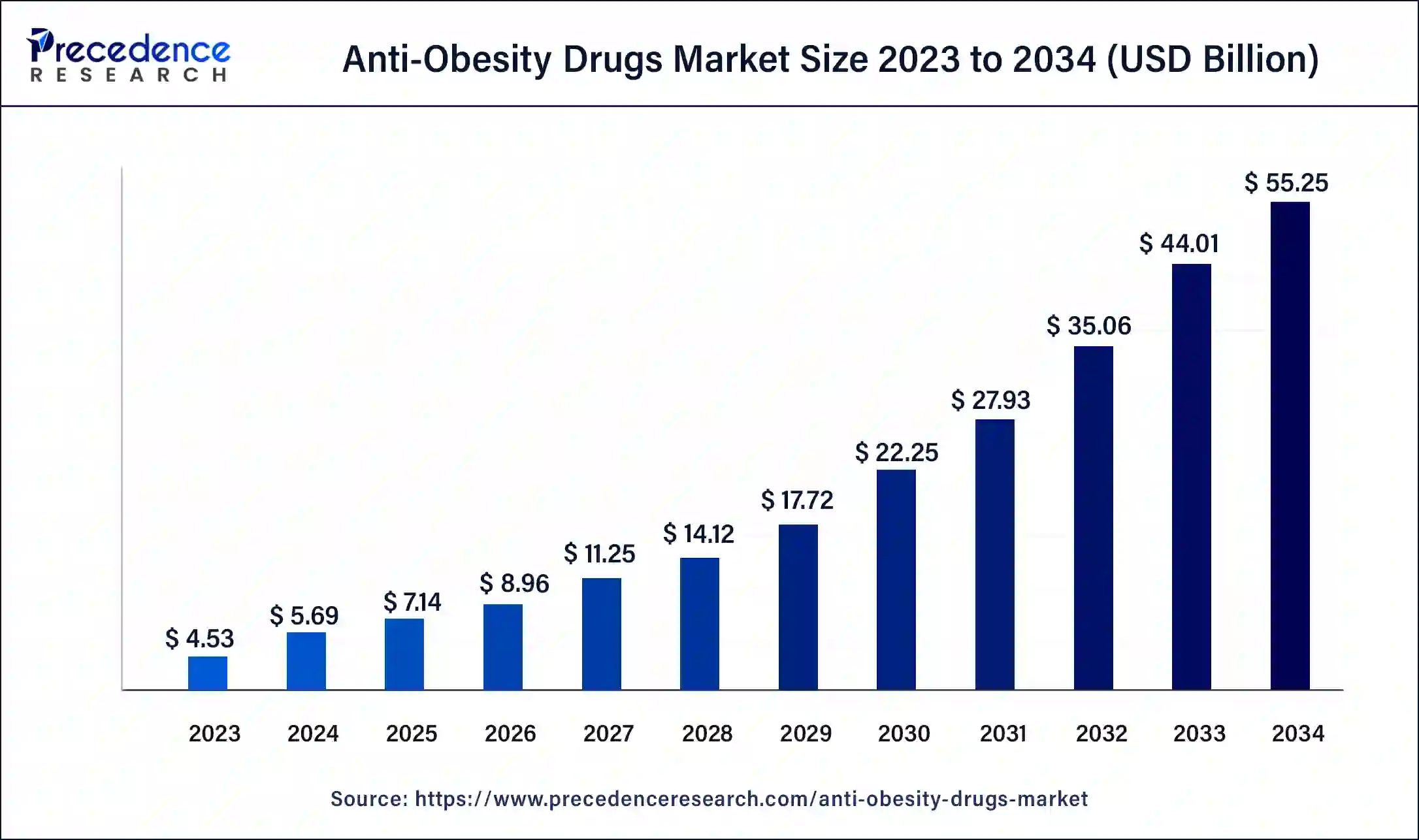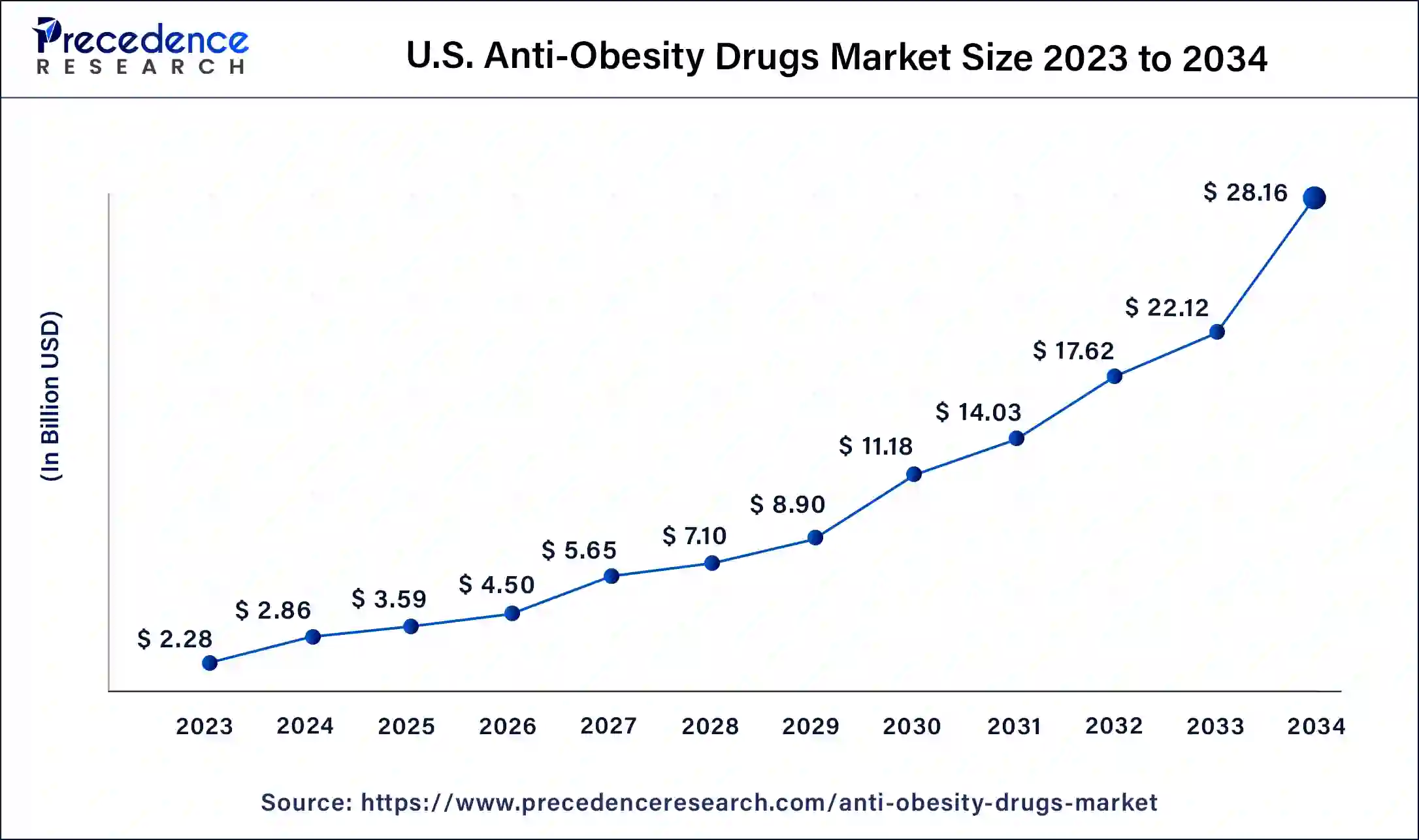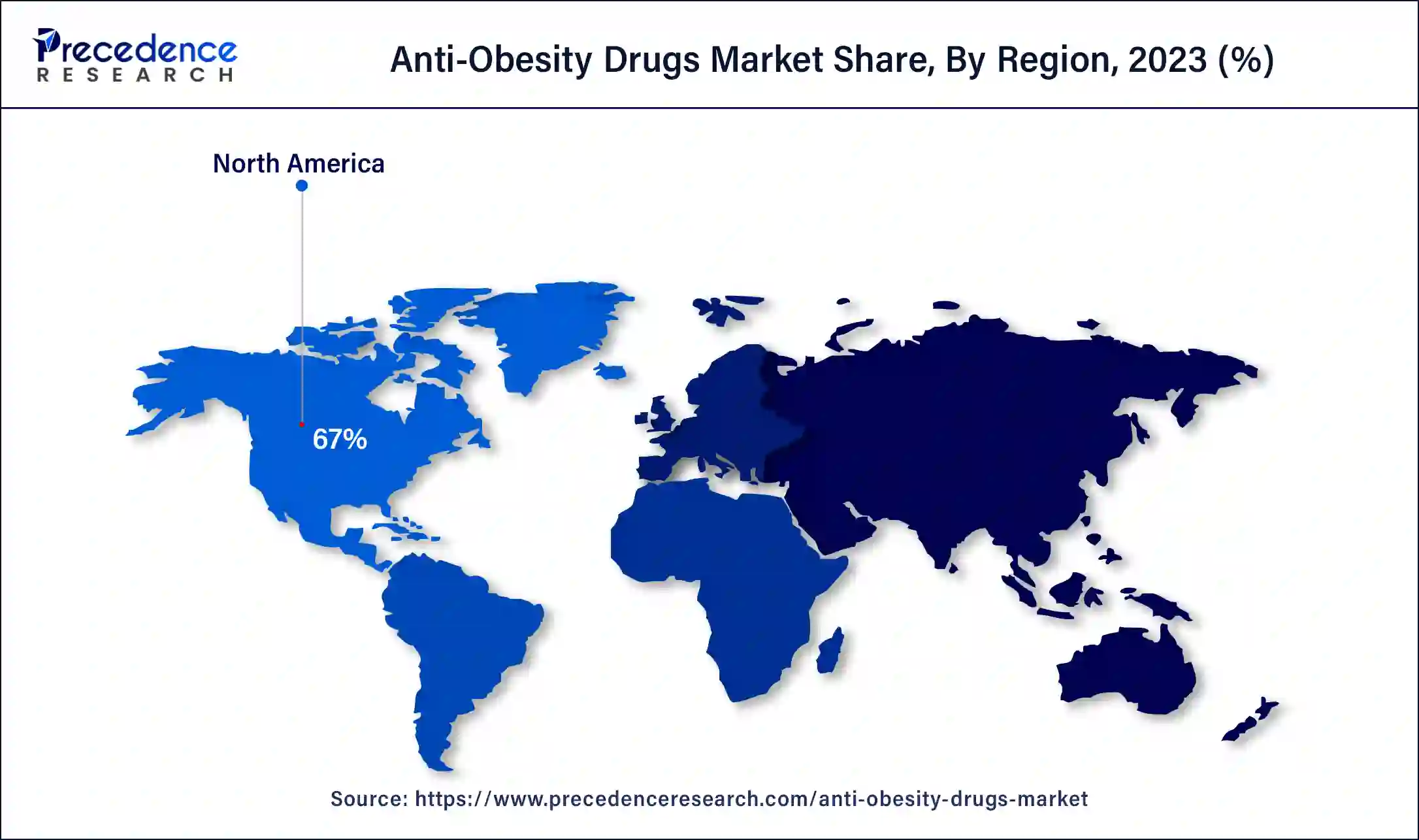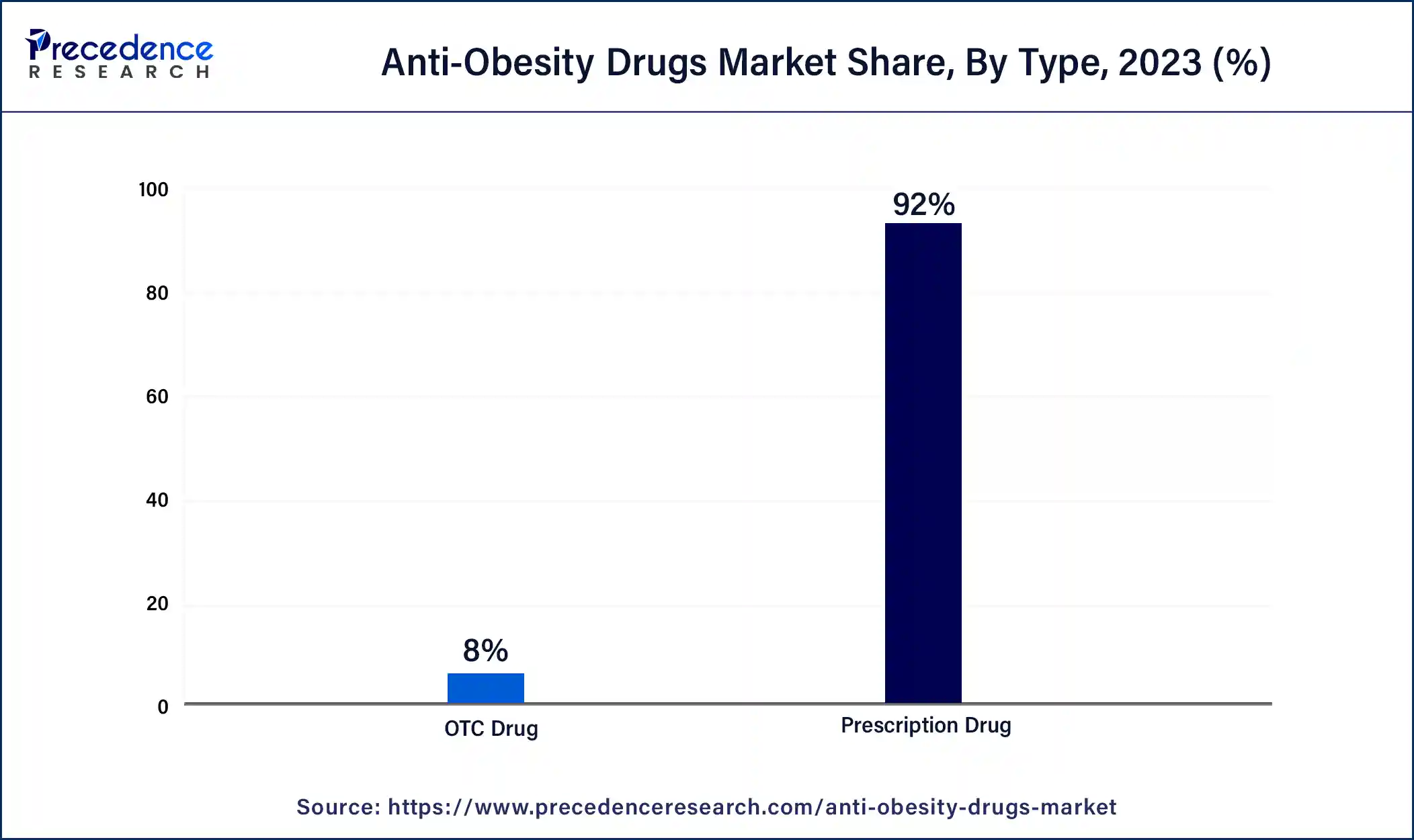List of Contents
Anti-Obesity Drugs Market Size and Forecast 2025 to 2034
The global anti-obesity drugs market size is accounted at USD 7.14 billion in 2025 and predicted to increase from USD 8.96 billion in 2026 to approximately USD 55.25 billion by 2034, at a CAGR of 5.53% from 2025 to 2034. The North America anti-obesity drugs market size reached USD 3.04 billion in 2023. The increase in the incidence of obesity has led to a large patient population suffering from debilitating problems, which is the key factor driving the anti-obesity drugs market growth.

Anti-Obesity Drugs Market Key Takeaways
- In terms of revenue, the market is valued at $7.14 billion in 2025.
- It is projected to reach $55.25 billion by 2034.
- The market is expected to grow at a CAGR of 5.53% from 2025 to 2034.
- North America contributed more than 67% of market share in 2024.
- Asia Pacific is set to host the fastest-growing market over the forecast period.
- By type, the prescription drug segment generated the biggest market share of 92% of market share in 2024.
- By type, the OTC drug segment is observed to grow at a notable growth rate over the forecast period.
- By distribution channel, the retail & online pharmacy segment led the market in 2024.
- By distribution channel, the hospital pharmacy segment is observed to grow at a notable growth rate in the market over the projected period.
How Artificial Intelligence is Transforming the Weight Loss Market
Artificial intelligence is having a significant impact on the anti-obesity drugs market by enabling researchers and healthcare professionals to predict the health status of obese patients, suggest the best treatment plans, and offer regular monitoring of applied drugs to assess their functioning inside the patients' bodies. Patients can get access to advanced solutions such as precision medicine and the real-time data generated can be used to study the performance efficacy of those drugs through patients' response to them.
Machine learning and deep learning are enhancing disease prediction accuracy through accurate medical imaging and storing of patients' personal health information both securely and reliably. AI-based learning helps to identify behavioral, and diet patterns, and some other AI-assisted applications include remote monitoring, providing personal weight loss management assistance with standardized treatment outcomes.
- In May 2024, Terns Pharmaceuticals announced the reported data on phase 1 human clinical trials of TERN-601, a glucagon-like-peptide-1-receptor agonist (GLP-1 receptor) for obesity to treat obese patients with weight loss management solutions.
U.S. Anti-Obesity Drugs Market Size and Growth 2025 to 2034
The U.S. anti-obesity drugs market size was exhibited at USD 3.59 billion in 2025 and is projected to be worth around USD 28.16 billion by 2034, poised to grow at a CAGR of 25.67% from 2025 to 2034.

North America dominated the global anti-obesity drugs market in 2024. The growth of the anti-obesity drugs market in the region is driven by several factors, including the rising rates of obesity, advancements in drug development technologies, and the approval of numerous new medications by the U.S. FDA. In North America, the market is projected to experience moderate growth due to the increasing prevalence of obesity.
As of 2024, the United States holds the largest market share in the region, a position it is likely to maintain due to its significant obese population. The U.S. is expected to remain the leader in both the North American and global anti-obesity drugs market, thanks to the availability of FDA-approved drugs and the high rates of both adult and childhood obesity.
- In April 2024, the article published by BioPharma Reporter says the U.S. is to see a surge in new obesity drug launches in the next five years. Over the past two decades, there has been a marked increase in obesity rates among U.S. adults, with projections indicating a continuing upward trend.

Asia Pacific is set to host the fastest-growing anti-obesity drugs market over the forecast period. This is due to the increasing prevalence of obesity, driven by sedentary lifestyles and unhealthy eating habits. Additionally, growing awareness of obesity-related health risks, such as heart disease, diabetes, and cancer, is contributing to this growth. The demand for anti-obesity medications is rising, particularly in developing countries like India, China, Japan, and South Korea. This growth is further supported by an upsurge in clinical research focused on obesity management and the escalating prevalence of obesity-related conditions such as diabetes and cardiovascular diseases in the region.
- In January 2024, Cipla Ltd has prepared to launch drugs for diabetes and obesity in India, other emerging markets, and the U.S., as it sees a huge opportunity for these formulations, a top official of the pharmaceutical company said.GLP-1 (Glucagon-like peptide 1) for diabetes and obesity is a very big transformation, equivalent to statins for cholesterol control.
Europe is observed to grow at a considerable rate in the upcoming period in the anti-obesity drugs market. It is stemming from higher obesity rates, supportive healthcare policies with strong health infrastructure, and an increasing demand for weight loss treatments. Also, the World Health Organization reports that a significant portion of adults and children in the WHO European Region are overweight or obese. Thus, the increasing emphasis on regional pharmacological solutions for obesity management is further contributing to its significance in the global market.
Market Overview
Anti-obesity medications are prescribed to help individuals who are overweight or obese achieve weight loss. These drugs work through various mechanisms, such as curbing appetite, boosting metabolism, or preventing the absorption of dietary fat. They are generally categorized into three main types based on their mode of action: those that inhibit fat absorption in the intestines, those that suppress food intake, and those that increase energy expenditure.
The anti-obesity drugs market encompasses a range of pharmaceutical solutions designed to aid weight loss and mitigate associated health risks. The medications function in diverse ways, including reducing hunger, interfering with nutrient absorption, or modifying neurotransmitter levels that affect metabolism and feelings of fullness. Hence, these prescriptions are typically accompanied by recommendations for lifestyle changes to maximize effectiveness.
Anti-Obesity Drugs Market Growth Factors
- The increasing awareness regarding obesity treatment is expected to drive market growth in the anti-obesity drugs market.
- A rise in investments in R&D activities by pharmaceutical companies for the development of more effective anti-obesity drugs can lead to the anti-obesity drugs market growth.
- Growing focus on holistic and individualized medicine can fuel the anti-obesity drugs market growth shortly.
Market Scope
| Report Coverage | Details |
| Market Size by 2034 | USD 55.25 Billion |
| Market Size in 2025 | USD 7.14 Billion |
| Market Size in 2026 | USD 8.96 Billion |
| Market Growth Rate from 2025 to 2034 | CAGR of 5.53% |
| Largest Market | North America |
| Base Year | 2025 |
| Forecast Period | 2025 to 2034 |
| Segments Covered | Type, Distribution Channel, and Regions |
| Regions Covered | North America, Europe, Asia-Pacific, Latin America, and the Middle East & Africa |
Market Dynamics
Drivers
Combination therapies
Combining different anti-obesity drugs with various mechanisms is recognized as an effective approach for managing weight. Unlike single-drug treatments, combination therapies offer several advantages, including potential synergistic effects, reduced side effects, and broader coverage of the underlying factors contributing to obesity. Pharmaceutical companies are actively exploring diverse drug combinations to develop more comprehensive and effective treatment options. Moreover, regulatory bodies such as the FDA and EMA are focusing m on assessing the efficacy and safety of these anti-obesity medications, which could further propel the anti-obesity drugs market.
- In February 2024, Herbalife, a premier health and wellness company and community, announced the launch of the Herbalife GLP-1 Nutrition Companion, a new range of food and supplement product combos fueled by the #1 Protein Shake in the World and intended to support the nutritional needs of individuals on GLP-1 and other weight-loss medications. Herbalife's Classic and Vegan options are now available in the United States and Puerto Rico in a variety of flavors.
Restraint
Lack of education
Despite the growing global prevalence of obesity, treatment rates remain low due to insufficient education on weight management and widespread misconceptions. Research indicates that only 2% of the entire obese population receives treatment with prescription medications. This limited uptake is a key factor hindering the anti-obesity drugs market growth. Additionally, the market's expansion is constrained by the presence of only a few major players focused on developing obesity treatments and the side effects associated with these medications.
Opportunity
Rising prevalence of morbid obesity
A significant trend in the anti-obesity drugs market is the rising incidence of childhood and morbid obesity. The growing prevalence of morbid obesity is often associated with increased demands on healthcare resources, such as challenges in transporting, transferring, and examining patients. Furthermore, Routine procedures, including blood draws, X-rays, computed tomography (CT) scans, and emergency bedside ultrasounds, become more time-consuming for individuals with morbid obesity. Therefore, the escalating rates of both childhood and morbid obesity are expected to drive demand by fueling market growth throughout the forecast period.
Global Obesity Statistics (2022)
| Category | Statistics (2022) |
| Global Prevalence of Obesity | 1 in 8 People Worldwide |
| Adults Overweight | 2.5 Billion Adults (18 years and Older) |
| Adults Living with Obesity | 890 Million |
| Adults Aged 18+ Overweight | 43% |
| Adults Aged 18+ Living with Obesity | 16% |
| Children Under 5 Overweight | 37 Million |
| Children & Adolescents Aged 5–19 Overweight | Over 390 Million |
| Children & Adolescents Aged 5–19 Living with Obesity | 160 Million |
Type Insights
The prescription drug segment dominated the anti-obesity drugs market in 2024. The dominance of this segment can largely be attributed to the availability of therapeutically effective weight management medications, regardless of whether their action is central or peripheral. The increasing prevalence of obesity, driven by factors such as high alcohol consumption, fast food intake, and sedentary lifestyles, also contributes to the growing demand for these products.

The over the counter drug segment is observed to grow at a notable rate in the anti-obesity drugs market over the forecast period. The increase in e-commerce has significantly enhanced the accessibility and convenience of purchasing OTC anti-obesity medications online. This has made it easier for consumers to obtain these products. The over-the-counter pharmaceuticals sector covers a range of non-prescription medications, treatments, and healthcare items that consumers can buy directly without the need for a prescription from a licensed healthcare provider.
- In March 2024, Taisho Pharmaceutical announced that it would start marketing the April anti-obesity drug orlistat, the first such drug to become available without a prescription in Japan. The drug, which will be available from April 8 under the brand name Alli, is expected to reduce fat stored around internal organs and prevent obesity-related diseases. It is intended for overweight people aged 18 or older, with a waist circumference of 85 centimeters for men and 90 cm for women.
Distribution Channel Insights
The retail & online pharmacy segment led the anti-obesity drugs market in 2024. This can be attributed to the rise in the use of e-pharmacy platforms and the availability of anti-obesity medications through these channels, which has simplified the drug procurement process and contributed to the increased prevalence of obesity and related chronic conditions globally. Moreover, factors driving the growing demand for online pharmacies include enhanced patient convenience, substantial cost savings, timely accessibility, drug shortages in retail stores, and the expansion of e-commerce.
The hospital pharmacy segment is observed to grow at a notable growth rate in the anti-obesity drugs market over the projected period. The growing prevalence of obesity and the increased demand for prescription-based anti-obesity medications are driving factors in this trend. The availability of affordable medications has led to a strong preference for frequent purchases at local pharmacies, contributing to the retail pharmacy sector's growth. Furthermore, the advancement of online platforms for delivering both prescription and over-the-counter medications to patients is expected to significantly boost the expansion of the online pharmacy market.
Anti-Obesity Drugs Market Companies
- Alvogen Iceland EHF
- Amgen Inc.
- AstraZeneca Plc
- Boehringer Ingelheim International GmbH
- Eli Lilly and Co.
- Empros Pharma AB
- ERX Pharmaceuticals Inc.
- Gelesis Inc.
- GlaxoSmithKline Plc
- Innovent Biologics Inc.
- LG Chem Ltd.
- Novo Nordisk AS
- Rhythm Pharmaceuticals Inc.
- SCOHIA PHARMA Inc.
- VIVUS LLC
- Zydus Lifesciences Ltd.
Leaders Announcements
- In May 2025, Manu Chakravarthy, head of cardiovascular, renal and metabolism product development at Roche, announced acquisition rights to an obesity therapy from Zealand Pharma in Denmark, opening a new chapter in a collaboration deal worth USD 5.3 billion, as the Swiss drugmaker looks to boost its prospects in the booming weight-loss market. The agreement also covered compound petrelintide of Zealand signals renewed efforts by Roche to get the obesity market leader, Novo Nordisk.
- In May 2024, Novo Nordisk signed a research tie-up with US biotech firm Metaphore to develop next-generation obesity drugs. Novo is trying to expand beyond its blockbuster obesity drug Wegovy with at least eight other treatments in its research and developmant pipeline for the condition. Also, the collaboration will use the tech platform of Metaphore to develop two therapies for obesity.
Recent Developments
- In March 2025, American pharmaceutical major Eli Lilly and Company launched its diabetes and obesity management drug Mounjaro (tirzepatide) in India. The company launched the drug in a single-dose vial following marketing authorisation from the Central Drugs Standard Control Organisation (CDSCO). The release noted that Mounjaro was a treatment for obesity, overweight, and Type 2 diabetes that activates both GIP and GLP-1 hormone receptors.
- In January 2023, the U.S. Food and Drug Administration (FDA) approved Lastacaft (alcaftadine ophthalmic solution), a 0.25% over-the-counter drug for the treatment of allergic conjunctivitis.
- In February 2023, Futura Medical announced that it is preparing to seek FDA approval for MED3000, an over-the-counter erectile dysfunction treatment.
- In October 2022, the U.S. FDA granted Eli Lilly's Mounjaro (tirzepatide) a fast-track designation for its use as a treatment for obesity. Mounjaro is a glucose-dependent insulinotropic polypeptide (GIP) receptor and glucagon-like peptide-1 (GLP-1) receptor agonist that is used for the treatment of adults with obesity or overweight with weight-related comorbidities.
Segments Covered in the Report
By Type
- Prescription Drug
- OTC Drug
By Distribution Channel
- Hospital Pharmacy
- Retail & Online Pharmacy
By Geography
- North America
- Asia Pacific
- Europe
- Latin America
- Middle East & Africa
For inquiries regarding discounts, bulk purchases, or customization requests, please contact us at sales@precedenceresearch.com
Frequently Asked Questions
Ask For Sample
No cookie-cutter, only authentic analysis – take the 1st step to become a Precedence Research client